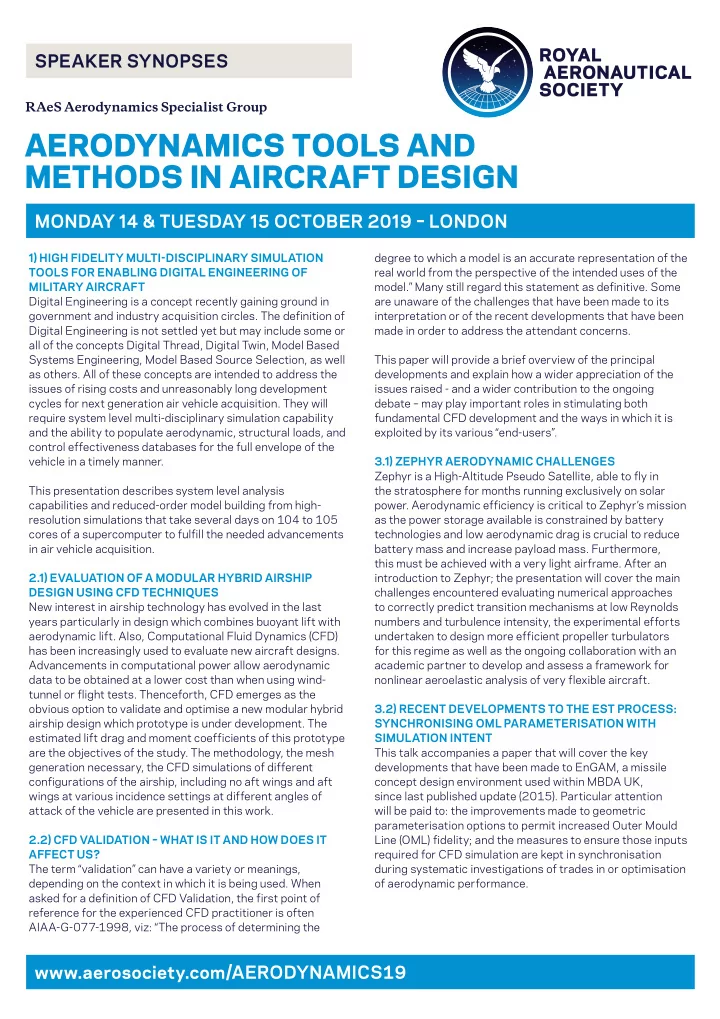

SPEAKER SYNOPSES RAeS Aerodynamics Specialist Group AERODYNAMICS TOOLS AND METHODS IN AIRCRAFT DESIGN MONDAY 14 & TUESDAY 15 OCTOBER 2019 – LONDON 1 ) HIGH FIDELITY MULTI-DISCIPLINARY SIMULATION degree to which a model is an accurate representation of the TOOLS FOR ENABLING DIGITAL ENGINEERING OF real world from the perspective of the intended uses of the MILITARY AIRCRAFT model.” Many still regard this statement as definitive. Some Digital Engineering is a concept recently gaining ground in are unaware of the challenges that have been made to its government and industry acquisition circles. The definition of interpretation or of the recent developments that have been Digital Engineering is not settled yet but may include some or made in order to address the attendant concerns. all of the concepts Digital Thread, Digital Twin, Model Based Systems Engineering, Model Based Source Selection, as well This paper will provide a brief overview of the principal as others. All of these concepts are intended to address the developments and explain how a wider appreciation of the issues of rising costs and unreasonably long development issues raised - and a wider contribution to the ongoing cycles for next generation air vehicle acquisition. They will debate – may play important roles in stimulating both require system level multi-disciplinary simulation capability fundamental CFD development and the ways in which it is and the ability to populate aerodynamic, structural loads, and exploited by its various “end-users”. control effectiveness databases for the full envelope of the vehicle in a timely manner. 3.1) ZEPHYR AERODYNAMIC CHALLENGES Zephyr is a High-Altitude Pseudo Satellite, able to fly in This presentation describes system level analysis the stratosphere for months running exclusively on solar capabilities and reduced-order model building from high- power. Aerodynamic efficiency is critical to Zephyr’s mission resolution simulations that take several days on 104 to 105 as the power storage available is constrained by battery cores of a supercomputer to fulfill the needed advancements technologies and low aerodynamic drag is crucial to reduce in air vehicle acquisition. battery mass and increase payload mass. Furthermore, this must be achieved with a very light airframe. After an 2.1) EVALUATION OF A MODULAR HYBRID AIRSHIP introduction to Zephyr; the presentation will cover the main DESIGN USING CFD TECHNIQUES challenges encountered evaluating numerical approaches New interest in airship technology has evolved in the last to correctly predict transition mechanisms at low Reynolds years particularly in design which combines buoyant lift with numbers and turbulence intensity, the experimental efforts aerodynamic lift. Also, Computational Fluid Dynamics (CFD) undertaken to design more efficient propeller turbulators has been increasingly used to evaluate new aircraft designs. for this regime as well as the ongoing collaboration with an Advancements in computational power allow aerodynamic academic partner to develop and assess a framework for data to be obtained at a lower cost than when using wind- nonlinear aeroelastic analysis of very flexible aircraft. tunnel or flight tests. Thenceforth, CFD emerges as the obvious option to validate and optimise a new modular hybrid 3.2) RECENT DEVELOPMENTS TO THE EST PROCESS: SYNCHRONISING OML PARAMETERISATION WITH airship design which prototype is under development. The SIMULATION INTENT estimated lift drag and moment coefficients of this prototype are the objectives of the study. The methodology, the mesh This talk accompanies a paper that will cover the key generation necessary, the CFD simulations of different developments that have been made to EnGAM, a missile configurations of the airship, including no aft wings and aft concept design environment used within MBDA UK, wings at various incidence settings at different angles of since last published update (2015). Particular attention attack of the vehicle are presented in this work. will be paid to: the improvements made to geometric parameterisation options to permit increased Outer Mould 2.2) CFD VALIDATION – WHAT IS IT AND HOW DOES IT Line (OML) fidelity; and the measures to ensure those inputs AFFECT US? required for CFD simulation are kept in synchronisation The term “validation” can have a variety or meanings, during systematic investigations of trades in or optimisation depending on the context in which it is being used. When of aerodynamic performance. asked for a definition of CFD Validation, the first point of reference for the experienced CFD practitioner is often AIAA-G-077-1998, viz: “The process of determining the www.aerosociety.com/AERODYNAMICS19
Recommend
More recommend